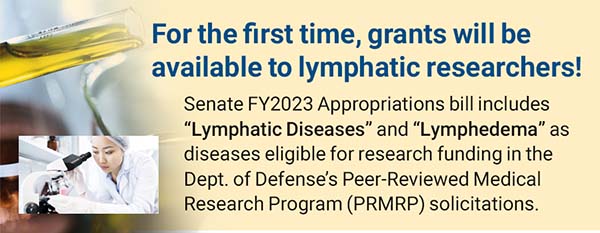Dear Researchers and LE&RN Advocates,
We have news of enormous consequence to both researchers and the patient community. Thanks to lobbying efforts by LE&RN and its advocates, the Senate FY 2023 Appropriations bill includes “Lymphatic Diseases” and “Lymphedema” as diseases eligible for research funding in its Peer-Reviewed Medical Research Program (PRMRP) solicitations. We are working to make sure the final Defense Appropriations bill includes these two important topics on its list of eligible conditions for study and should know the outcome late in the calendar year. This will be the first time in the history of this program that grants will be available to lymphatic researchers. In FY2022, this program was funded at $370 million, with about 30 conditions eligible for study.
The Congressional Directed Medical Research Program (CDMRP) originated in 1992 via a Congressional appropriation to foster novel approaches to biomedical research in response to the expressed needs of its stakeholders-the American public, the military, and Congress. Hallmarks of the CDMRP include investing in groundbreaking research and targeting critical gaps. It is also invested in supporting both the next generation of researchers and established scientists: hence, funding the full pipeline of research development, including basic, translational, and clinical research.
In 1999, the Peer-Reviewed Medical Research Program (PRMRP) was established with a goal of enhancing the health, care, and well-being of military Service members, Veterans, retirees, and their family members.
As you plan your FY2023 research proposal, remember you are applying to the Department of Defense (DOD), and your proposal will be reviewed for its potential impact on DOD needs. A critical part of LE&RN’s strategy with Congress was to point out how the list of burn pit diseases aligned with lymphatic diseases. For instance, head cancer is one of the leading outcomes of burn pit exposure. Research demonstrates that up to 75% of those with head and neck cancer are later diagnosed with LE. Check out the list of diseases associated with the burn pits. From here you can begin to build your case as to how these diseases could benefit from lymphatic research. We are now in the process of having LE added to the list of diseases eligible for VA health care under the recently passed Pact Act. Check out the list of presumptive diseases listed on this site associated burn pit exposure. This bill extends health care benefits to service personnel affected by the burn pits. Melanoma and breast cancer, the treatment of which can lead to LE, also has a higher incidence in military personnel than the population at large. Given the systemic impact of lymphatics, you will be looking for the various ways the military can benefit from lymphatic research. See below for more details on the research process.
The final bill will likely be voted on before the end of 2022. However, now is the time for lymphatic researchers to begin familiarizing themselves with the opportunities and the mechanism of applying for grants under this program.
You can learn more about the categories and funding mechanisms at this website (note: this site refers to the FY2021 program, however, there is every reason to believe that they FY2023 program will follow this formula. You’ll note that LD & LE were previously not listed as eligible diseases): https://www.depts.ttu.edu/research/downloads/CDMRPPRMRPSolicitations.pdf
Review Process:
Although Congress decides which topic areas are funded, DOD program managers and Joint Program Committees (JPCs) retain authority in program directions and are influential in shaping the direction of CDMRP programs. CDMRP employs a rigorous two-tier review process: scientific, peer review and programmatic review. The programmatic review is intended to address the relevance of the proposed research to DOD’s needs; therefore, it is important for both the pre-application and the full proposal to consider the topic area in relation to the mission of DOD and the “Areas of Encouragement” described in the appendix of each solicitation. Additional information about the two-tier review process is available here or a video here.
Finally, success doesn’t occur in a vacuum. Our thanks to Dale Dirks and Phil Goglas of Health & Medicine Council of Washington who advised and nurtured LE&RN through this lobbying process, and who set up the dozens of meetings between LE&RN and virtually every legislator associated with the DOD. A special note of thanks to retired Coast Guard Officer Kelly Bell. Kelly was on virtually every Zoom meeting I had with legislators where he told his compelling story of living with a lymphatic disease that he developed in the military. Lastly, we thank Kathy Bates who brought both her celebrity and passion to bear in supporting this effort.
William Repicci
President & CEO
Funding mechanisms top areas in FY2021 included:
Funding Mechanisms:
• The Discovery Award supports the exploration of a highly innovative new concept or untested theory in the topic area(s) of interest. Postdoctoral or clinical fellow and above are eligible.
• The Focused Program Award supports multidisciplinary research with multiple investigators, addressing an overarching goal in the topic area(s) of interest. Projects may range from exploratory/hypothesis development through small-scale clinical trials.
• The Investigator-Initiated Research Award supports novel research focused on patient care and allows for partnering of primary investigators.
• The Technology/Therapeutic Development Award supports the translation of preclinical findings into clinical applications for prevention, detection, diagnosis, treatment, or quality of life in the topics area(s) of interest. This is a product-oriented award.
• The Clinical Trial Award supports the implementation of clinical trials to evaluate products, pharmacologic agents, devices, clinical guidance and emerging approaches and technologies that may significantly impact one of the diseases listed under the FY 2021 PRMRP topic areas.
